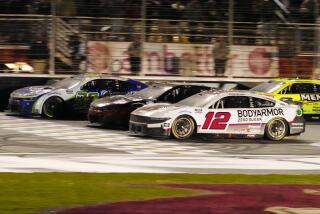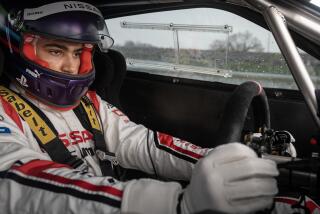A closer look at cycling
- Share via
Editor’s note: AP Sports Writer Tim Reynolds spent Stage 1 of the Tour de Georgia inside the Health Net/Maxxis team car, a rare up-close look at the peleton and the workers managing both the cyclists and the race.
SAVANNAH, Ga. -- Mike Tamayo walks over to the car, extends his hand in greeting, then allows a wry smile to cross his face.
“We’ll be on two wheels only once or twice,” he says.
He was kidding.
For a moment, given the reputation of how team-car drivers maneuver during races, his visitor wasn’t sure.
Tamayo is director of the Health Net/Maxxis pro cycling team, one of the 15 squads entered in this week’s Tour de Georgia, which began Monday morning with a 71-mile stage that started in the beachfront town of Tybee Island and ended in downtown Savannah. He runs the show.
Most importantly, perhaps, he drives the car.
He slides behind the wheel at 10:25 a.m. Monday, moments before the Tour begins. For the next two hours and 40 minutes, he’ll steer with either one hand or one knee (yikes), arrange the delivery of a set of tires (for the car, which is in dire need of repair), work two walkie-talkies to stay in contact with his team and race officials, hand bottles of water and other drinks to his riders, deftly pull onto the grassy shoulder to pass bikes, take a half-dozen calls on his iPhone and even authorize the purchase of tickets for the team’s next race.
“It’s a good day,” he says.
He makes the job seem easy. It’s not.
The team car is the epicenter, the brains of a race team.
Ninety minutes before the stage begins, long before the riders emerge from their hotel rooms, Health Net has their wagon already loaded up. There’s a cooler behind the backseat, stuffed with water bottles. Six tires, ready to snap onto a racer’s bike at a moment’s notice, are leaned against the cooler, with two more wheels packed into the back seat and two others strapped to the car roof, alongside four replacement bikes.
They’re ready for almost anything.
Eva Barabas is the mechanic, who takes her spot behind the passenger seat, which typically is vacant (although on this day, a reporter was invited along for the ride, with his knees pressed against the dashboard the entire time). She’s the only female mechanic in the Tour de Georgia, and she thinks she might be the lone female to oversee the workings of any pro team.
“I don’t get butterflies,” says Barabas, who was an amateur racer before working in a Connecticut bike shop and eventually getting hired as the mechanic for a poorly funded, low-level women’s team. “I get premonitions, like it’s going to be a bad day.”
No such premonitions Monday, though. That’s a relief.
Tamayo puts the car into drive, takes his spot in the row of vehicles, and the race is underway. It starts with a 10-kilometer “neutral” portion, which means the entire peleton will remain together.
Barely 10 minutes into the race, there’s a problem. Not with the team. The car tires -- a shipment of 12 tires for cars and vans, actually -- haven’t been delivered to the hotel, and Tamayo is frustrated.
He steers with his left knee while negotiating the delivery and telling the person on the other end of the phone line that he’s in a bike race and no, fax machines aren’t exactly accessible at the moment.
Midway through the stage, the cyclists begin a sprint alongside a school, where at least 100 elementary kids are lined up, waving from the side of the road.
Someone tosses a water bottle their way. Mayhem ensues. Four kids dive on the bottle, and a few kids dive on them as well.
Tamayo’s phone rings. The tires have been found. Someone from the team can pick them up in the afternoon.
“Appreciate that,” Tamayo says, then hangs up and slides the phone back into its spot on the dashboard.
There’s 25 kilometers to go. Tamayo is thrilled. Pipp is part of a breakaway that opens an 80-second gap on the field.
At day’s end, Karl Menzies is listed as the team’s top finisher, in a pack sitting 10 seconds off the lead.
A solid day. Not really good, not really bad, so Tamayo has no complaints. He’s the calm in the eye of the storm, almost unflappable.
“Things just kind of ramp up throughout the race,” Tamayo said, shortly before pulling the car into its spot at the finish. “You try to keep it level. When we cross the finish line, the guys will be ramped up. They’re taking caffeine, they’ve got testosterone flowing like crazy, they come up to the finish line bumping and shoving and elbowing and pushing. So you keep everybody in line and positive. That’s the key.”
More to Read
Sign up for The Wild
We’ll help you find the best places to hike, bike and run, as well as the perfect silent spots for meditation and yoga.
You may occasionally receive promotional content from the Los Angeles Times.






